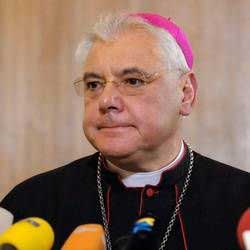|
 (www.RemnantNewspaper.com) (www.RemnantNewspaper.com)
UPDATE: (8/10/12) It has come to
my attention that the English translation I used in
quoting Abp. Muller's work "Katholische
Dogmatik" is incorrect. The correct translation places
Archbishop Muller's words even more definitively against
the Traditional understanding of the perpetual virginity
of the Blessed Virgin Mary. In the original German text,
Archbishop Muller uses the words, "Es
geht nicht um..." Literally translated these words mean,
"It is not about...." Thus, Archbishop Muller did not
say the perpetual virginity of Mary, "is not
so much concerned with specific physiological
proprieties in the natural process of birth
..." Instead, he said the perpetual virginity of
Mary, "is not about specific physiological
proprieties in the natural process of birth ..."
In an August 6 EWTN News/CNA article, Archbishop Gerhard
Müller,
new head of the Vatican’s
Congregation for the Doctrine of the Faith (CDF), makes
his first brief, but substantive public response to
doctrinal criticisms from Traditionalists. Ironically,
in attempting to clarify his positions, the Archbishop
may end up demonstrating (intentionally or
unintentionally) the mind of the Modernists towards
dogma.
In Pascendi, St. Pius X explains that the Modernists
separate Faith and science in an effort to appease
rationalists. While the Modernists will recite the
language of Catholic dogma and profess belief in it, it
is always with the understanding that dogma itself is an
expression or a symbol of a divine reality that only has
true relevance when it is adapted to the faith or
“religious sense” of the believer. In our present day
this “faith or religious sense” must always take into
account our present rationalistic and agnostic world
which questions the very idea of the supernatural. Does
Archbishop Müller demonstrate this view in his
responses?
On August 6, Archbishop Müller defended his view of
Church teaching on the Eucharist by stating: “Our
Catholic faith is very clear...that at the consecration
during Mass a change occurs so that the whole substance
of the bread and wine is changed into the whole
substance body and blood of Jesus Christ, and that this
change is rightly called transubstantiation. And we have
refused to accept all the other interpretations,
consubstantiation, transignification, transfinalisation
and so on.”
So what is the “whole substance of the body and blood of
Jesus Christ” according to Archbishop Müller? He
explains in his 2002 book,
"Die Messe - Quelle des christlichen Lebens":
In reality, the body and blood of Christ do not mean
the material components of the human person of Jesus
during his lifetime or in his transfigured corporality.
Here, body and blood mean the presence of Christ in the
signs of the medium of bread and wine.
The Archbishop also defended his view of Church teaching
on the perpetual virginity of Mary stating, “The Church
is also equally clear on the ‘virginity of Mary, mother
of Jesus, mother of God, before, during and after the
birth of Christ.’” However, the Archbishop has
previously made clear that the word “virginity” used in
the formula he cites, does not necessarily include
bodily integrity as it has always been held to mean by
Catholic Tradition.
In his 2003 work "Katholische Dogmatik. Für Studium
und Praxis der Theologie" Müller claims that the
dogma of Mary’s perpetual virginity is:
...not so much concerned with specific physiological
proprieties in the natural process of birth (such as the
birth canal not having been opened, the hymen not being
broken, or the absence of birth pangs), but with the
healing and saving influence of the grace of the Savior
on human nature.
Thus, despite the Archbishop’s reciting of the Catholic
definitions, the question remains as to whether the
Archbishop interprets the words of those definitions to
have the exact same meaning as the Church has always
taught. For even if certain interpretations of dogmas
are well adapted to the “religious sense” of the modern
believer or the philosopher or the scientist, those
interpretations lose all value if they are not clearly
and unambiguously consistent with the unchangeable
original meanings given to them by the Church.
As St. Pius X warns us in Pascendi:
...the philosopher regards it as certain that the
representations of the object of faith are merely
symbolical...since symbols are but symbols in regard to
their objects and only instruments in regard to the
believer, it is necessary first of all, according to the
teachings of the Modernists, that the believer does not
lay too much stress on the formula, as formula, but
avail himself of it only for the purpose of uniting
himself to the absolute truth which the formula at once
reveals and conceals, that is to say, endeavors to
express but without ever succeeding in doing so. They
would also have the believer make use of the formulas
only in as far as they are helpful to him, for they are
given to be a help and not a hindrance; with proper
regard, however, for the social respect due to formulas
which the public magisterium has deemed suitable for
expressing the common consciousness until such time as
the same magisterium shall provide otherwise.
Link to article:
http://www.ewtnnews.com/catholic-news/Vatican.php?id=5927 |
